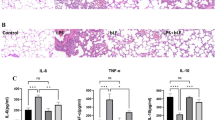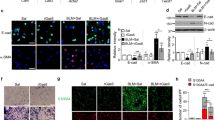Abstract
Apart from cytotoxicity cadmium has no special attributes towards cell’s physiological function. The role of cadmium with respect to cell growth is still under debate. Mitogen activated protein kinase and Ca2+/calmodulin dependent protein kinase dependent pathways are the two elaborately studied concerning cadmium induced cell proliferation. Low concentration of cadmium chloride (2.5 μM) was applied to mice primary lung epithelial cells and cell proliferation was measured both by cell cycle analysis and Brdu incorporation assay. Effects of differential dose of cadmium chloride on lung epithelial cells were evaluated morphologically by atomic force microscopy. RT-PCR and western blot altogether corroborated the specific signalling pathways concerning cadmium induced lung cell proliferation. Cadmium induced lung epithelial cells which over-expressed EGFR, were transfected with siEGFR, revealed downstream molecules and RNAi induced EGFR silencing. Use of siEGFR effectively prevents expression of proinflammatory and cell proliferative markers. Moreover N-acetyl cysteine and ascorbic acid mediated inhibition of EGFR and downstream signalling molecules indicate the involvement of reactive oxygen species. Exposure to low concentration of cadmium promotes the growth of primary mice lung epithelial cell by EGFR signalling. We have also transfected the primary lung epithelial cell with siRNA against the regulatory subunit of nuclear factor-κB (NF-κB) and the data shows that cadmium induced lung cell proliferation is the effect of EGFR mediated NF-κB activation.







Similar content being viewed by others
Abbreviations
- CaMKII:
-
Ca2+/calmodulin-dependent protein kinase-II
- c-Myc:
-
Myelocytomatosis viral oncogene homolog
- Cox-2:
-
Cyclooxygenase-2
- EGFR:
-
Epidermal growth factor receptor
- Erk:
-
Extracellular signal-regulated kinases
- IL-1β:
-
Interleukin-1β
- IL-6:
-
Interleukin-6
- Jnk:
-
c-Jun N-terminal kinase
- MAPK:
-
Mitogen activated protein kinase
- MMP:
-
Matrix metalloproteinases
- NAC:
-
N-Acetyl cysteine
- NF-κB:
-
Nuclear factor-κB
- STAT3:
-
Signal transducer and activator of transcription-3
- TNF-α:
-
Tumor necrosis factor-α
References
Aggarwal BB, Shishodia S, Sandur SK, Pandey MK, Sethi G (2006) Inflammation and cancer: How hot is the link? Biochem Pharmacol 72:1605–1621
Alroy I, Yarden Y (1997) The ErbB signaling network in embryogenesis and oncogenesis: signal diversification through combinatorial ligand-receptor interactions. FEBS Lett 410:83–86
Barham SS, Tarara JE, Enger MD (1985) Cadmium as a transforming growth factor. Fed Proc Fed Am Soc Exp Biol 44:520
Bonizzi G, Karin M (2004) The two NF-kappaB activation pathways and their role in innate and adaptive immunity. Trends Immunol 25:280–288
Chatterjee M, Dwivedi VK, Khandekar K, Tandon SK (2004) Chelation in metal intoxication XLVI: synthesis of some alpha-mercapto-beta-substituted aryl acrylic acids and their in vitro cadmium chelating ability. Biomed Environ Sci 17:27–32
Chibber R, Ord M (1990) Cadmium-induced multistep transformation of cultured indian muntjac skin fibroblasts. Biol Metals 3:213–221
Corti M, Brody AR, Harrison JH (1996) Isolation and primary culture of murine alveolar type II cells. Am J Respir Cell Mol Biol 14:309–315
Ding W, Templeton DM (2000) Activation of parallel mitogen-activated protein kinase cascades and induction of c-fos by cadmium. Toxicol Appl Pharmacol 162:93–99
Duan GW, Xu L, Song S, Zhu WuL (2009) Biphasic effect of cadmium on cell proliferation in human embryo lung fibroblast cells and its molecular mechanism. Toxicol In Vitro 23:973–978
Jarnicki A, Putoczki T, Ernst M (2010) Stat3: linking inflammation to epithelial cancer—more than a “gut” feeling? Cell Div 17:5–14
Järup L, Berglund M, Elinder CG, Nordberg G, Vahter M (1998) Health effects of cadmium exposure-a review of the literature and a risk estimate. Scand J Work Environ Health 24:1–51
Jin P, Ringertz NR (1990) Cadmium induces transcription of proto-oncogenes c-jun and c-myc in rat L6 myoblasts. J Biol Chem 256:14061–14064
Jorissen RN, Walker F, Pouliot N, Garrett TP, Ward CW, Burgess AW (2003) Epidermal growth factor receptor: mechanisms of activation and signalling. Exp Cell Res 284:31–53
Joseph P (2009) Mechanisms of cadmium carcinogenesis. Toxicol Appl Pharmacol 238:272–279
Kundu S, Sengupta S, Chatterjee S, Mitra S (2009) Cadmium induces lung inflammation independent of lung cell proliferation: a molecular approach. J Inflamm (Lond) 12:6–19
Lee JW, Soung YH, Kim SY, Park WS, Nam SW, Lee JY, Yoo NJ, Lee SH (2005) Absence of EGFR mutation in the kinase domain in common human cancers besides non-small cell lung cancer. Int J Cancer 113:510–511
Levinthal DJ, Defranco DB (2005) Reversible oxidation of Erk-directed protein phosphatases drives oxidative toxicity in neuron. J Biol Chem 280:5875–5883
Li M, Kondo T, Zhao QL, Li FJ, Tanabe K, Arai Y, Zhou ZC, Kasuya M (2000) Apoptosis induced by cadmium in human lymphoma U937 cells through Ca calpain and caspase-mitochondria-dependent pathways. J Biol Chem 275:39702–39709
Li Y, Yan J, Xu W, Wang H, Xia Y (2011) Lentivirus-mediated ADAM17 RNA interference inhibited interleukin-8 expression via EGFR signaling in lung epithelial cells. Inflammation 35(3):850–858
Ohshima H, Tatemichi M, Sawa T (2003) Chemical basis of inflammation induced carcinogenesis. Arch Biochem Biophys 41(7):3–11
Sasaki H, Endo K, Konishi, Takada M, Kawahara M, Iuchi K, Matsumura A, Okumura M, Tanaka H, Kawaguchi T, Shimizu T, Takeuchi H, Yano M, Fukai I, Fujii Y (2005) EGFR mutation status in Japanese lung cancer patients: genotyping analysis using light cycler. Clin Cancer Res 11:2924–2929
Satarug S, Moore MR (2004) Adverse health effects of chronic exposure to low-level cadmium in foodstuffs and cigarette smoke. Environ Health Perspect 112:1099–1103
Sorahan T, Lancashire RJ (1997) Lung cancer mortality in a cohort of workers employed at a cadmium recovery plant in US: an analysis with detail job history. Occup Environ Med 54:194–201
Tandon SK, Singh S, Prasad S, Khandekar K, Dwivedi VK, Chatterjee M, Mathur N (2003) Reversal of cadmium induced oxidative stress by chelating agent, antioxidant or their combination in rat. Toxicol Lett 14:211–217
Vesey DA (2010) Transport pathways for cadmium in the intestine and kidney proximal tubule: focus on the interaction with essential metals. Toxicol Lett 198:13–19
von Zglinicki T, Edwall C, Ostlund E, Lind B, Nordberg M, Ringertz NR, Wroblewski J (1992) Very low cadmium concentrations stimulate DNA synthesis and cell growth1. J Cell Sci 103:1073–1081
Xiao W, Liu Y, Templeton DM (2009) Pleiotropic effects of cadmium in mesangial cells. Toxicol Appl Pharmacol 238:315–326
Yi J, Liu LZ, Jiang Y, Zhu Y, Guo NL, Barnett J, Rojanasakul Y, Agani F, Jiang BH (2011) Cadmium increases HIF-1 and VEGF Expression through ROS, ERK and AKT signaling pathways and induces malignant transformation of human bronchial epithelial cells. Toxicol Sci 125(1):10–19
Acknowledgments
Authors want to thank Mr. Soham Mitra for his help in immunofluorescence and western blot study. Authors are very much grateful to Mr.Tarun Keswani who helped a lot in cell cycle data analysis and Mr. Samir Jana and Mr.Subir Biswas, for their continuous help during cell maintenance and siRNA experiments. Authors would like to thank Dr. Tarak Das Basu and Lab members (University of Kalyani) for their immense help in providing AFM. Mr Santanu Paul helped us during statistical data analysis. Mr. Saiful Alam Mir provided some valuable protease inhibitors. Authors heartily thank Miss Suranjana Goswami for her valuable contribution in rewriting the manuscript and language correction. This work is fully supported by the grant of Indian Council of Medical Research (ICMR), Govt. of India, and sanctioned project 3/2/2/166/2008/NCD-III. This work was partly supported by grants from Department of Science and Technology, Govt. of India (SR/FT/L-42/2006). Also we like to thank Department of Biotechnology, Govt.of India (BT/PR9779/GBD 27/67/2007).
Conflict of interest
The authors have no competing interests.
Author information
Authors and Affiliations
Corresponding author
Electronic supplementary material
Below is the link to the electronic supplementary material.

Supplementary Fig. 1
Application of natural antioxidant AA. a Ascorbic acid down regulated the expression of EGFR and its downstream molecules indicated cadmium induced ROS generation and up regulation of these molecules are shown by western blot result. Bar graphs indicated the values of above figures represented by relative density of the bands normalized to β-actin. Data represent three independent experiments (*p < 0.05). b ELISA of specific cytokines depicted that ROS production controlled their regulations in cadmium-induced lung EC. Bar graphs indicated the values of above figures represented by relative density of the bands normalized to β-actin. Data represent three independent experiments with (*p < 0.05; **p < 0.01) (JPEG 40 kb)
Rights and permissions
About this article
Cite this article
Kundu, S., Sengupta, S. & Bhattacharyya, A. NF-κB acts downstream of EGFR in regulating low dose cadmium induced primary lung cell proliferation. Biometals 26, 897–911 (2013). https://doi.org/10.1007/s10534-013-9666-7
Received:
Accepted:
Published:
Issue Date:
DOI: https://doi.org/10.1007/s10534-013-9666-7




